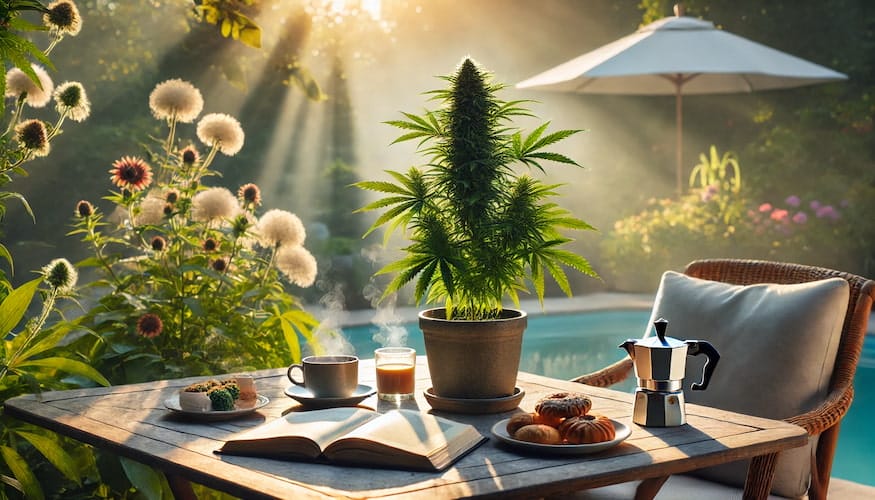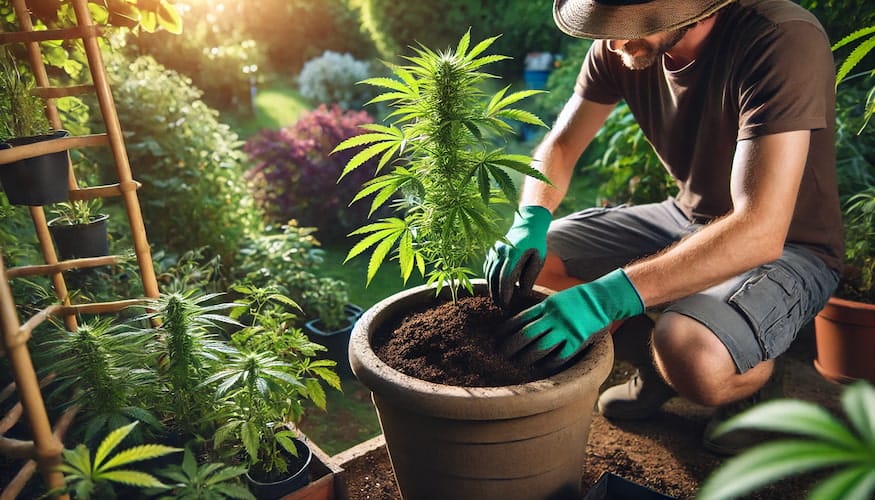Watering cannabis plants might seem straightforward, but it’s a delicate balance that plays a critical role in the health and productivity of your crop. Whether you’re a novice or an experienced grower, understanding the nuances of watering can make a significant difference in the quality and quantity of your harvest. This guide will walk you […]
Cannabis Plant Stress and Recovery
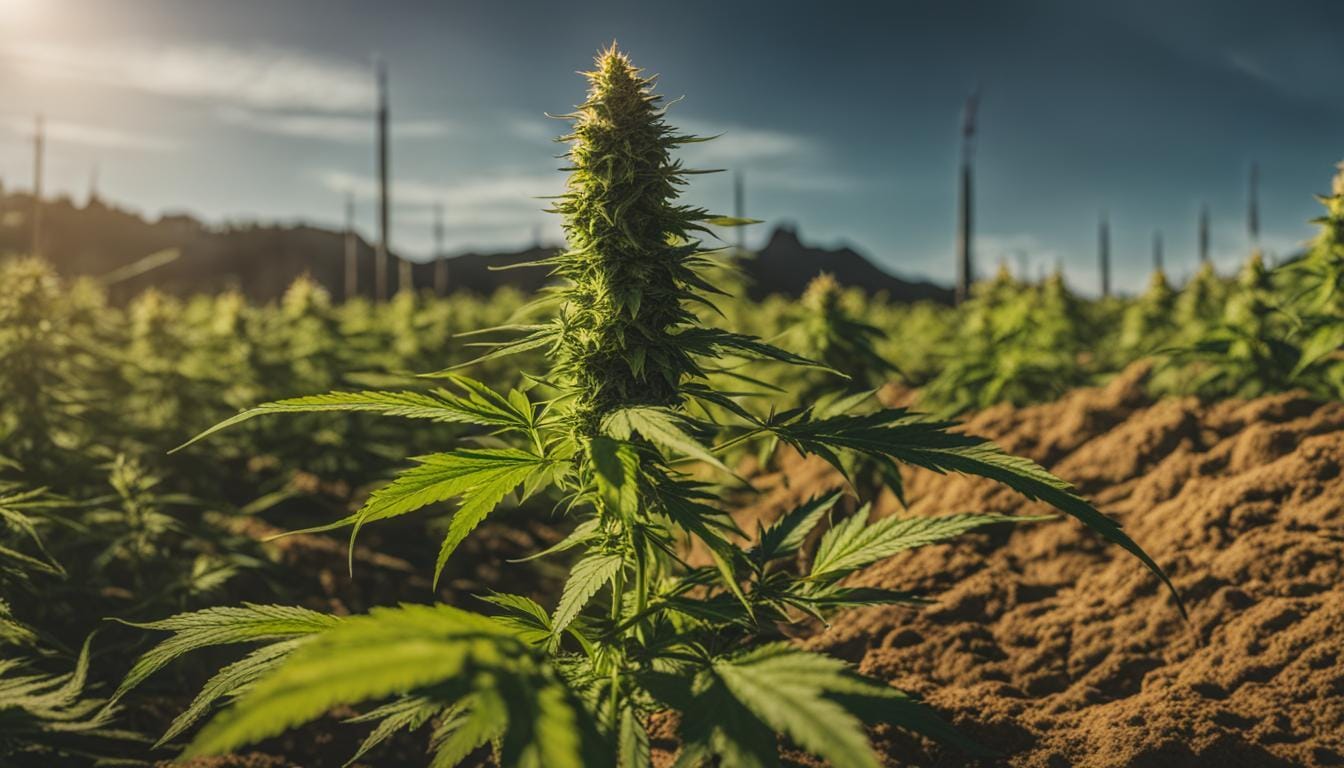
Growing cannabis plants can be a satisfying and rewarding experience, but it’s not always smooth sailing. Just like any living organism, marijuana plants are susceptible to stress, which can impact their health and ultimately, the quality of the final product. In this article, we’ll be discussing how to identify and manage stress in cannabis plants, as well as providing expert tips and techniques for plant recovery. By implementing proper care and understanding the signs of cannabis plant stress, you can ensure that your garden remains healthy and thriving.
Key Takeaways:
- Stress in cannabis plants can be caused by a variety of factors, including environmental conditions, pests, disease, and nutrient imbalances
- Recognizing the signs of stress is crucial for addressing the underlying issues and promoting plant recovery
- Mitigating stressors, implementing pest and disease management, and addressing nutrient imbalances are all essential for maximizing plant health and recovery
- Providing support for plant recovery through techniques such as pruning and plant training is crucial for promoting overall growth
- Selecting high-quality seeds and maintaining proper hygiene can significantly contribute to reducing stress and promoting plant health
Understanding Cannabis Plant Stress and Recovery
As cannabis growers, managing stress in our plants is always a top priority. Stress can lead to poor growth, reduced yields, and even plant death. In this section, we will discuss tips for reducing stress in cannabis plants and how to overcome stress when it does occur.
What Causes Stress in Cannabis Plants?
There are several factors that can contribute to cannabis plant stress and recovery. These include:
- Environmental conditions such as temperature, humidity, and light intensity
- Pest infestations and diseases
- Nutrient imbalances and deficiencies
- Over- or under-watering
- Physical damage
By understanding these factors, you can take steps to mitigate stress and promote plant health.
Tips for Reducing Stress in Cannabis Plants
Here are some tried-and-true techniques to reduce stress in cannabis plants:
- Provide a consistent environment: Maintaining stable temperatures and humidity levels, as well as providing consistent light cycles, can help reduce stress in plants.
- Implement preventive measures: Regularly inspecting plants for pests and diseases and using organic pest control methods can help prevent stress from occurring.
- Proper watering and feeding: Over- or under-watering, as well as improper nutrient levels, can contribute to stress. Using a consistent watering and feeding schedule can help prevent these issues.
- Pruning and training: Proper pruning and training techniques can help reduce stress by promoting healthy growth and preventing overcrowding.
- Stress-reducing practices: Techniques such as low-stress training, defoliation, and reducing light intensity during vegetative growth can help reduce stress and promote healthy growth.
Overcoming Cannabis Plant Stress
If stress does occur, there are steps you can take to help your plants recover:
- Identify and address the underlying issue: Use the techniques discussed in the next section to identify the source of stress and take appropriate measures to address it.
- Provide additional support: Using supplements such as kelp and humic acid, providing extra airflow, and reducing light intensity can all help support plant recovery.
- Be patient: It can take time for plants to recover from stress. Be patient and monitor your plants closely for signs of improvement.
By utilizing these tips and techniques, you can effectively manage stress in your cannabis plants and ensure healthy, thriving growth. In the next section, we will discuss how to identify the signs of stress in cannabis plants.
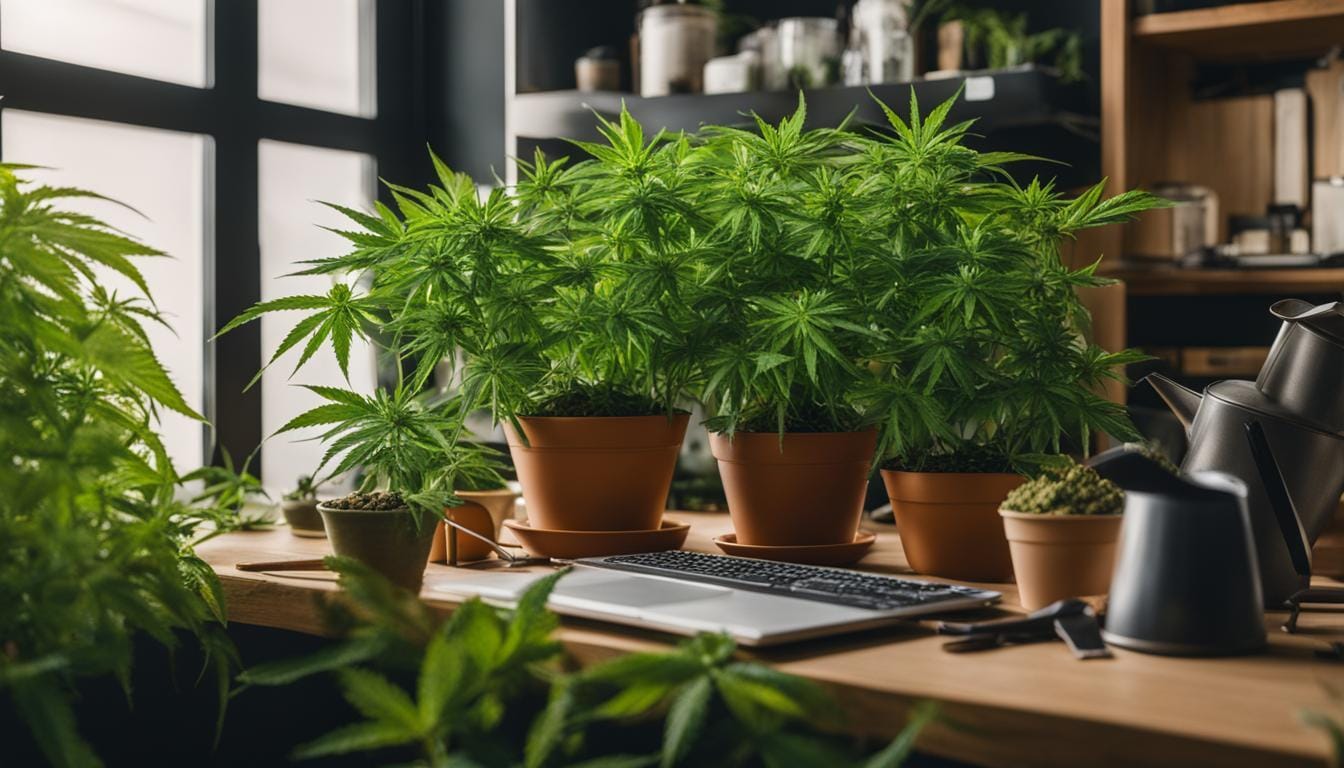
Identifying Signs of Cannabis Plant Stress
If you want to maintain a healthy and productive garden, it’s important to be able to identify common signs of stress in your plants. The sooner you can catch these indicators, the quicker you can take action to help your plants recover.
Leaf Discoloration
One of the most common signs of stress in cannabis plants is leaf discoloration. If your plant’s leaves begin to yellow, brown, or become mottled, it could be a sign of nutrient deficiencies, improper watering, or other stress factors. By closely monitoring the color and texture of your plant’s leaves, you can identify and address the underlying cause of the problem.
Wilting
When cannabis plants are overwatered or underwatered, they may begin to wilt. This can also be a sign of root rot, pests, or other stressors. If you notice your plant’s leaves drooping or curling, it’s important to adjust your watering schedule and inspect your plant for any signs of disease or pest infestation.
Stunted Growth
If your cannabis plant is not growing as quickly as it should be, it could be a sign of stress. Stunted growth may be caused by a lack of nutrients, insufficient light, improper pH levels, or other environmental factors. By addressing these issues, you can help your plant resume healthy growth.
Nutrient Deficiencies
Cannabis plants require a balanced blend of nutrients to thrive. When there is an imbalance or deficiency, it can result in stress and poor growth. Common signs of nutrient deficiencies include yellowing leaves, brown spots, and slow growth. By monitoring your plant’s nutrient intake and adjusting your fertilization techniques, you can help your plant recover.
Common Signs of Cannabis Plant Stress
| Sign | Cause |
|---|---|
| Leaf discoloration | Nutrient deficiencies, improper watering, stress factors |
| Wilting | Overwatering/underwatering, root rot, pests |
| Stunted growth | Lack of nutrients, insufficient light, improper pH levels |
| Nutrient deficiencies | Imbalanced nutrient intake, poor fertilization techniques |
By being able to recognize these common signs of stress, you can take the necessary steps to help your cannabis plants recover and regain their health. In the next section, we will explore techniques for managing and reducing plant stress.
Environmental Stressors and Solutions
Managing stress in cannabis plants requires addressing environmental stressors that can negatively impact plant health. These stressors can include temperature fluctuations, humidity levels, light intensity, and improper watering practices. By understanding how these factors affect plant growth and implementing solutions, you can create a more stable and optimal growing environment for your plants.
Temperature Fluctuations
Temperature fluctuations can cause stress in cannabis plants, especially during the flowering stage. High temperatures can lead to wilting and leaf curling, while low temperatures can slow growth and cause discoloration. To prevent temperature stress, maintain a consistent temperature range of 68 to 77 degrees Fahrenheit during the day and 59 to 68 degrees Fahrenheit at night. A simple way to achieve this is by using a digital thermometer and a heater or fan to regulate temperature and airflow.
Humidity Levels
Humidity levels can also impact cannabis plant growth, as high humidity can encourage mold and mildew growth while low humidity can increase water loss and stress. To maintain optimal levels, aim for 50 to 60 percent humidity during the vegetative stage and 40 to 50 percent during the flowering stage. This can be achieved using a humidifier and dehumidifier as needed.
Light Intensity
Light intensity is crucial for cannabis plant growth and stress management. Insufficient light can lead to weak stems and decreased yields, while too much light can cause burning and discoloration. By providing your plants with the appropriate amount of light (around 600 watts per square meter for indoor plants), you can maximize plant health and recovery. Using high-quality LED grow lights can also improve energy efficiency and reduce heat stress.
Improper Watering Practices
Watering cannabis plants requires careful attention to avoid over- or under-watering. Overwatering can lead to root rot and mold growth, while underwatering can cause wilted leaves and stunted growth. To prevent these issues, follow a consistent watering schedule based on plant needs and environmental conditions. When watering, ensure the soil is moist but not waterlogged, and allow it to dry out slightly between waterings.
By managing environmental stressors and creating a stable growing environment, you can minimize stress in cannabis plants and promote overall health and recovery.
Pest and Disease Management
As with any plant, cannabis is susceptible to pests and diseases that can cause stress and hinder growth. It is crucial to take preventative measures to minimize the risk of infestation or infection.
Regular inspections of your plants can help you identify issues early on. Look for signs of insect damage, such as chewed leaves, webbing, or small moving dots. You may also notice discoloration, wilting, or stunted growth.
If you notice any of these signs, it is essential to take action immediately. Organic pest control methods, such as neem oil or insecticidal soap, can be effective in controlling pests. Additionally, maintaining good sanitation practices, such as cleaning your grow area regularly, can help prevent infestations.
Diseases can also impact plant health, causing stress and reducing yields. Common cannabis diseases include powdery mildew, botrytis, and root rot. These diseases can be caused by a variety of factors, including poor air circulation, high humidity, and improper watering practices.
To help prevent disease, it is vital to provide adequate airflow, avoid overcrowding your plants, and ensure proper drainage. If you notice any signs of disease, such as white powdery spots or discolored leaves, it is crucial to take action immediately. Treatments such as copper fungicides or essential oil blends can be effective in managing disease.
Remember, prevention is key when it comes to managing pests and diseases. Regular inspections and maintenance of your growing area can go a long way in overcoming plant stress and maximizing plant health.
Identifying Nutrient Imbalances and Deficiencies in Cannabis Plants for Recovery
Nutrient imbalances and deficiencies are commonly encountered by cannabis growers. These factors can cause stress in cannabis plants, stunting their growth significantly. Proper fertilization, pH balance, and adequate supply of essential nutrients are necessary to prevent nutrient imbalances and deficiencies in cannabis plants. In this section, I will discuss techniques for identifying and addressing nutrient imbalances and deficiencies in cannabis plants and how to help them recover.
Understanding Nutrient Imbalances
Nutrient imbalances may arise due to over or under-fertilization or poor soil quality. The most common nutrient imbalances in cannabis plants include nitrogen (N), phosphorus (P), potassium (K), calcium (Ca), and magnesium (Mg) deficiencies. Excessive or insufficient levels of these essential nutrients can lead to various symptoms.
- Nitrogen (N) Deficiency: Leaves appear pale and yellowish, and growth is stunted. The lower leaves may show more signs of nitrogen deficiency than the upper leaves.
- Phosphorus (P) Deficiency: Leaves appear dark green or blue-green, and the tips of leaves may appear bluish-yellow. Reduced internodal distances are noticed, and buds won’t grow significantly.
- Potassium (K) Deficiency: Leaves appear burnt, and the edges of leaves may be yellow or brown. The plant’s overall growth and yield may be reduced.
- Calcium (Ca) and Magnesium (Mg) Deficiencies: Leaves appear yellow, and the edges of the leaves may turn brown. The edges may start to curl up and look crispy. Calcium and magnesium deficiencies can occur simultaneously, and they may be responsible for some forms of stress in cannabis plants.
With nutrient imbalances, one must consider the growing medium’s pH level. When the pH is too high or too low, it can hinder a plant’s ability to absorb nutrients, causing nutrient imbalances.
Identifying Nutrient Deficiencies
Nutrient deficiencies may manifest in numerous ways. By detecting these signs early, growers can address the situation and get their plants back on track. Some common symptoms of nutrient deficiencies in cannabis plants are:
- Leaf discoloration, including yellowing, browning, or spotting
- Slow growth or stunted growth of the plant
- Leaf curling or twisting
- Leaf drop or dying leaves
Techniques for Recovery from Nutrient Imbalances and Deficiencies
The first step in addressing nutrient imbalances and deficiencies is to identify the underlying problem. Testing the pH level of the soil or growing medium and monitoring nutrient levels is crucial. Growers can adjust their fertilization regimen or adjust the pH of their growing medium to correct nutrient imbalances.
When addressing nutrient deficiencies, a grower must provide the deficient nutrients. In some cases, a nutrient deficiency may occur due to an overabundance of another nutrient, so it’s crucial to identify the nutrient’s specific deficiency before adding nutrients. The grower can add high-quality fertilizers and organic compost, or use supplements to improve the nutrient content of their soil or growing medium.
It’s also essential to avoid over-fertilization as it can cause nutrient lockout, which prevents plants from absorbing vital nutrients. In some cases, it may be necessary to flush the growing medium with pH-balanced water to remove excess salts and nutrients if a nutrient lockout has occurred.
Supporting Plant Recovery
Once you have identified and addressed the underlying causes of stress, it’s time to support your cannabis plant recovery. Here are some tips for maximizing your plant’s health and recovery:
- Pruning: Consider pruning your plants to remove dead or damaged foliage, improve airflow, and redirect energy to healthier parts of the plant. This can encourage new growth and improve overall plant health.
- Plant training: Consider using techniques such as topping, fimming, or LST (low-stress training) to promote plant growth and improve yield. However, be careful not to stress your plants too much during training, as this can lead to further damage.
- Adequate light: Ensure that your plants are receiving the proper amount and intensity of light, as this plays a crucial role in plant growth and recovery. Consider investing in high-quality grow lights or optimizing natural light sources.
- Airflow: Good airflow is essential for healthy plant growth, as it can prevent issues such as mold and mildew. Consider using fans or adjusting your growing environment to promote proper ventilation.
- Stress-reducing practices: Finally, consider implementing stress-reducing techniques such as massage or sound therapy to support your plant’s recovery. While these methods may seem unconventional, some growers swear by their effectiveness.
Remember, every plant is different, and recovery times can vary depending on the severity of the stress. Be patient and attentive to your plants’ needs, and they will reward you with healthy growth and robust yields.
“Healthy plants mean happy growers. Take the time to care for your plants, and they will take care of you in return.”
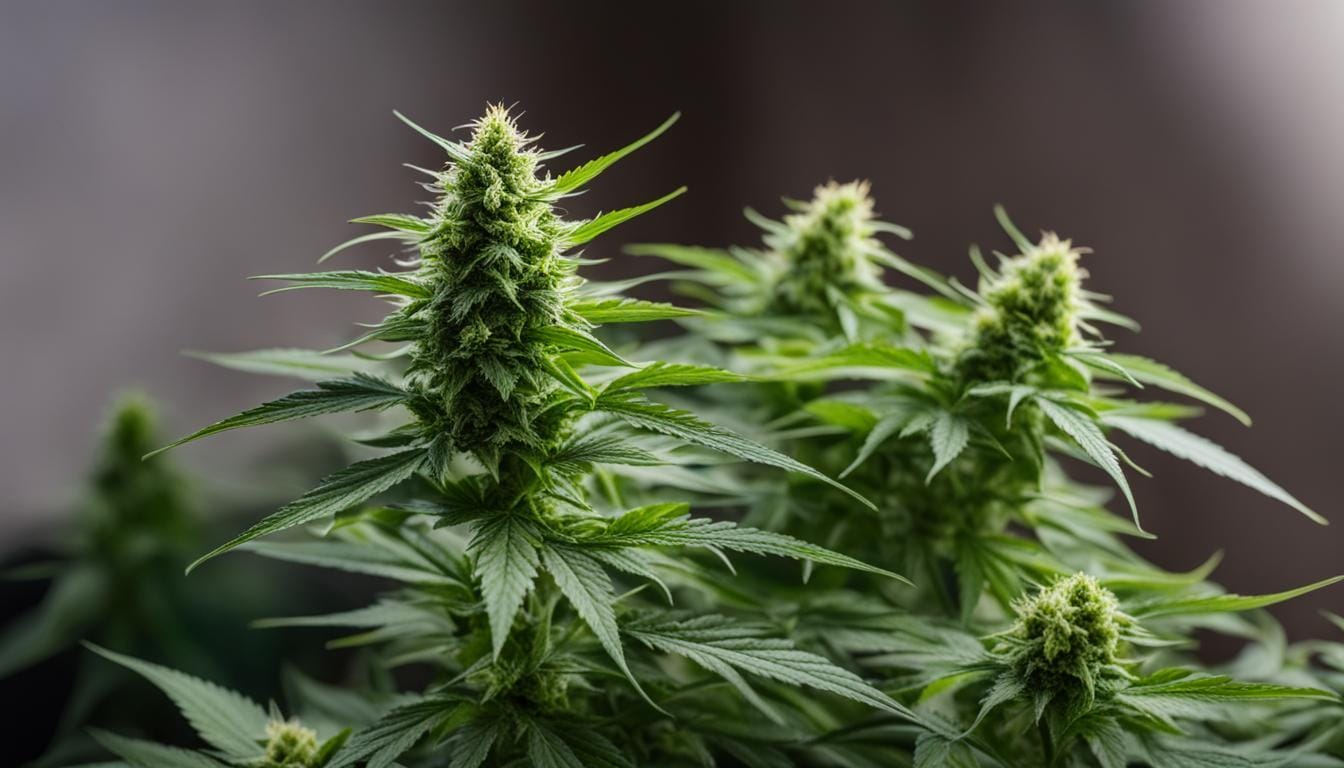
Best Practices for Cannabis Plant Care
When it comes to caring for your cannabis plants, there are several best practices that can help reduce stress and promote recovery. First and foremost, choosing high-quality seeds from reputable seed banks such as Seeds Here Now is essential to ensure the health and vitality of your plants.
Once you have your seeds, maintaining proper hygiene is crucial to prevent disease and pests. This includes washing your hands before handling plants, sterilizing tools, and regularly cleaning the grow area.
Another key factor in cannabis plant care is implementing a consistent watering and feeding schedule. Overwatering or underwatering can both contribute to stress, so it’s important to strike a balance and monitor the plants’ response to ensure they receive just the right amount of water.
Finally, providing proper lighting and ventilation can also help reduce stress and maximize growth. Make sure your plants receive enough light to thrive, and ensure adequate airflow to minimize the risk of disease.
Conclusion
Managing stress in cannabis plants is an essential aspect of successful cultivation. By paying attention to environmental factors, pests, diseases, and nutrient deficiencies, you can identify signs of stress and take appropriate steps to alleviate them. Implementing proper care techniques, such as pruning, plant training, and stress reduction, can help support plant recovery and overall health.
It’s essential to maintain best practices for cannabis plant care, including selecting high-quality seeds from reputable seed banks, maintaining proper hygiene, and staying on top of watering and feeding schedules. By doing so, you can minimize the risk of stress and maximize the potential of your cannabis garden.
Remember, keeping your cannabis plants healthy and stress-free takes time and effort, but the rewards are well worth it. By following the tips and techniques outlined in this article, you can ensure that your plants remain healthy and thrive. Managing stress in cannabis plants is key to a successful and bountiful harvest.
Now that you’ve learned how to keep your plants healthy and happy, get growing with the collection of regular, feminized, and autoflower cannabis seeds at Seeds Here Now.
FAQ
How can I identify stress in my cannabis plants?
Signs of stress in cannabis plants can include leaf discoloration, wilting, stunted growth, and nutrient deficiencies. By observing these indicators, you can address the underlying issues and support plant recovery.
What are some common causes of stress in cannabis plants?
Environmental conditions, pests, disease, and nutrient imbalances can all contribute to plant stress. It’s important to recognize these factors and take appropriate measures to alleviate stress and promote plant health.
How can I create an optimal growing environment for my cannabis plants?
Mitigating environmental stressors such as temperature fluctuations, humidity levels, light intensity, and proper watering practices is essential. By providing a stable and controlled environment, you can maximize plant health and recovery.
How can I prevent pests and diseases from causing stress in my cannabis plants?
Regular inspections, organic pest control methods, and good sanitation practices are key to minimizing the risks of pests and diseases. Implementing preventive measures will help maintain a healthier growing environment for your plants.
What should I do if my cannabis plants have nutrient imbalances or deficiencies?
Proper fertilization, maintaining pH balance, and ensuring essential nutrients are provided in the right quantities are crucial. By addressing nutritional issues, you can support plant recovery and overall growth.
How can I support plant recovery after identifying and addressing stressors?
Techniques such as pruning, plant training, providing adequate light and airflow, and implementing stress-reducing practices can help optimize plant health and aid in recovery.
What are some best practices for cannabis plant care?
Selecting high-quality seeds from reputable seed banks, maintaining proper hygiene, and following a consistent watering and feeding schedule are important for plant health and reducing the risk of stress.
How can I ensure the health and vitality of my cannabis plants?
By understanding the causes and signs of stress, implementing appropriate measures for recovery, and following the techniques and best practices outlined in this article, you can maximize the potential of your cannabis garden.
Back


